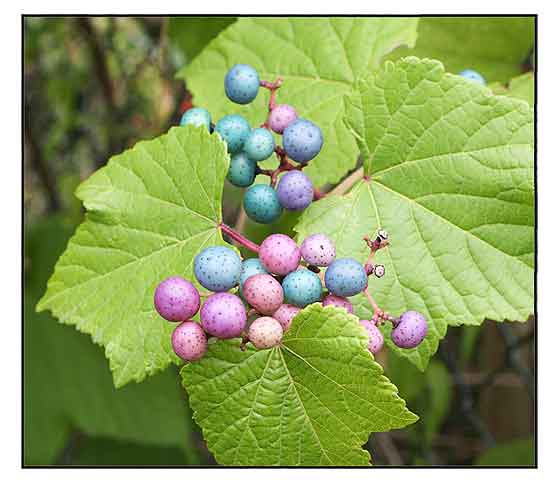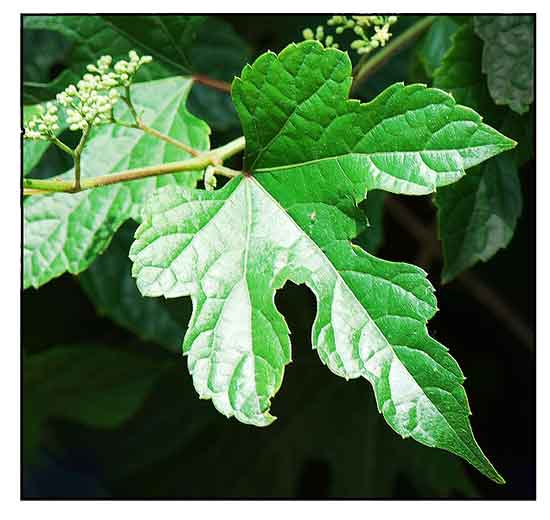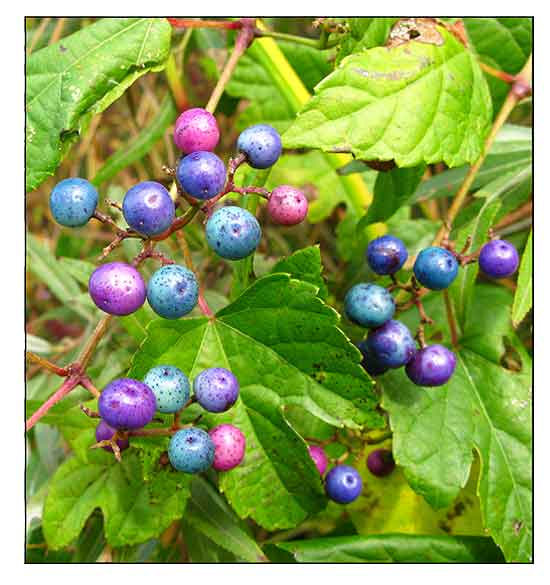 Gen info Gen info
- Ampelopsis is a genus of climbing shrubs int the grape family Vitaceae.
-
Etymology: The genus name Ampelopsis derives from Greek words ampelos, meaning 'vine' and opis meaning 'sight, appearance, or likeness'. Specific epithet brevis is Latin for 'short' or 'abridged', and pedunculata is a Latinized form of 'peduncle'.
-
Sometimes confused with grape species (genus Vitis) and other Ampelopsis species.
Botany
•
Branchlets terete, with longitudinal ridges; tendrils 2- or 3-branched. Leaves simple, 3-5-cleft, usually mixed with some undivided leaves; petiole 1-7 cm; leaf blade 3.5-14 × 3-11 cm, basal veins 5, lateral veins 4 or 5 pairs, veinlets inconspicuously raised, base cordate, notches nearly obtuse, rarely rounded, margin with acute teeth, apex acute. Peduncle 1-2.5 cm. Pedicel 1-3 mm. Buds ovoid, 1-2 mm, apex rounded. Petals ovate-elliptic, 0.8-1.8 mm. Anthers narrowly elliptic. Lower part of ovary adnate to disk; style slightly enlarged at base. Berry 5-8 mm in diam., 2-4-seeded. Seed narrowly elliptic.
(Flora of China)
 • Ampelopsis glandulosa is a deciduous, woody, perennial climbing vine with flowers and tendrils opposite the palmately lobed leaves, which have three to five more or less deep lobes and coarsely toothed margins (with a small apicle). Porcelain berry climbs via tendrils to a height of 4 to 6 meters (13 to 20 ft). The tendrils cling to the supports by non-adhesive tendrils similar to those of Vitis vines. Tendrils are opposite the leaves and have two or three branches. Inflorescence is a corymbiform cyme, attached opposite a leaf. Flowers are small, green-white, born in umbels opposite the leaves, and appear in June through August. Fruits are 4 to 8 millimeters (0.16 to 0.31 in) in diameter, circular, containing two to four seeds, and may be many colors including green, blue, purple, pink or yellow with black or brown speckles; many different colors are present on the same plant. The berries are produced in late summer and fall. The seeds are dispersed by birds. • Ampelopsis glandulosa is a deciduous, woody, perennial climbing vine with flowers and tendrils opposite the palmately lobed leaves, which have three to five more or less deep lobes and coarsely toothed margins (with a small apicle). Porcelain berry climbs via tendrils to a height of 4 to 6 meters (13 to 20 ft). The tendrils cling to the supports by non-adhesive tendrils similar to those of Vitis vines. Tendrils are opposite the leaves and have two or three branches. Inflorescence is a corymbiform cyme, attached opposite a leaf. Flowers are small, green-white, born in umbels opposite the leaves, and appear in June through August. Fruits are 4 to 8 millimeters (0.16 to 0.31 in) in diameter, circular, containing two to four seeds, and may be many colors including green, blue, purple, pink or yellow with black or brown speckles; many different colors are present on the same plant. The berries are produced in late summer and fall. The seeds are dispersed by birds.
Porcelain berry can be confused with native grapes based on leaf shape but can be differentiated by cutting the stem and observing the pith. Grapes have brown or tan pith but porcelain berry has white pith. Porcelainberry bark is also covered in lenticels and does not peel, unlike grape bark. (2)
 Distribution Distribution
- Native to the Philippines.
- Throughout the Philippines, in thickets chiefly at medium elevation, up to 2000 m in the Cordillera highlands. (3)
- Also native to
Assam, Bangladesh, China, Himalaya, Japan, Khabarovsk, Korea, Kuril Is., Laos, Manchuria, Myanmar, Nansei-shoto, Nepal, Primorye, Sakhalin, Taiwan, Vietnam. (1)
- It was introduced in the 1870s to the United States as a landscape plant. It has become invasive from Wisconsin and Iowa at its westernmost extent to the Atlantic coastline at the east, from New Hampshire to Georgia. (2)
- Birds consume the seeds of the berry and acts as vector in spreading it. (4)
Properties
- Widely planted as an ornamental, it can become rapidly invasive.
- Fresh fruits, roots, and leaves considered antiphlogistic, depurative, and febrifuge.
- Studies have suggested anti-inflammatory, anti-allergic rhinitis, antioxidant properties.
Parts used
Leaves, roots.
Uses
Edibility
- Fruits are edible, raw or cooked; but although edible, not particularly appetizing, described by some as slimy and bland.
- Leaves, leaf buds, and stems are edible; cooked.
Folkloric
- In China, used for treatment of boils, clots, ulcers, bruises and aches.
- In Asia, roots used for treatment of diabetes.
Studies
• Antioxidant / Anti-Inflammatory: Study evaluated the antioxidant activity of methanol extract of A. brevipedunculata using cell-free and cell culture systems. The cell-free system showed the MEAB exhibited dose-dependennt antioxidant activities against linoleic acid peroxidation and plasmid DNA oxidation. MEAB possessed strong reducing power and scavenging effects of hydroxyl radicals and DPPH free radicals. Pretreatment of co-treatment of HepG2 cells with MEAB significantly protected cells from H2O2-induced oxidative stress. Results suggest antioxidant effects may be via direct interaction between MEAB and exogenous oxidant sources. The antioxidant activity may explain its anti-inflammatory and anti-hepatotoxic effects. (4)
• Anti-Allergic Rhinitis: In vivo study on wild grape (Ampelopsis glandulosa var. brevipedunculata) hot water extract was conducted on phorbol myristate acetate (PMA)-induced or with histamine-induced upregulation of H1 receptor mRNA expression in human epithelial cells (HeLa). Stimulation of HeLa cells with PMA or histamine induced significant and transient decrease in H1R mRNA. The wild grape extract (WGE) suppressed histamine signaling through the inhibition of histamine-induced upregulation of H1R gene expression. The WGE showed strong activity in inhibiting histamine release conducted against AR-induced model and may be helpful in alleviating symptoms of allergic rhinitis. (5)
• Suppressive Effect on Transcriptional Up-Regulation of Allergic Sensitive Genes: Study investigated the effect of wild grape on the signaling pathways for PKCδ-mediated H1R and NFAT-mediated IL-9 gene expressions. WGE suppressed PMA-induced up-regulation of H1R gene expression in HeLa cells. The combination of wild grape extract with Awa-tea markedly alleviated nasal symptoms, a combination that will have distinct clinical and therapeutic advantages over existing antihistamines. Wild grape also suppressed PMA-induced IL-33 gene up-regulation in Swiss3T3 cells and expression level of IL-33 mRNA correlated with number of blood eosinophils in patients with pollinosis. Wild grape could be effective against eosinophilic inflammation. (6)
Availability
Wild-crafted.
Ornamental cultivation.
|

![]()






